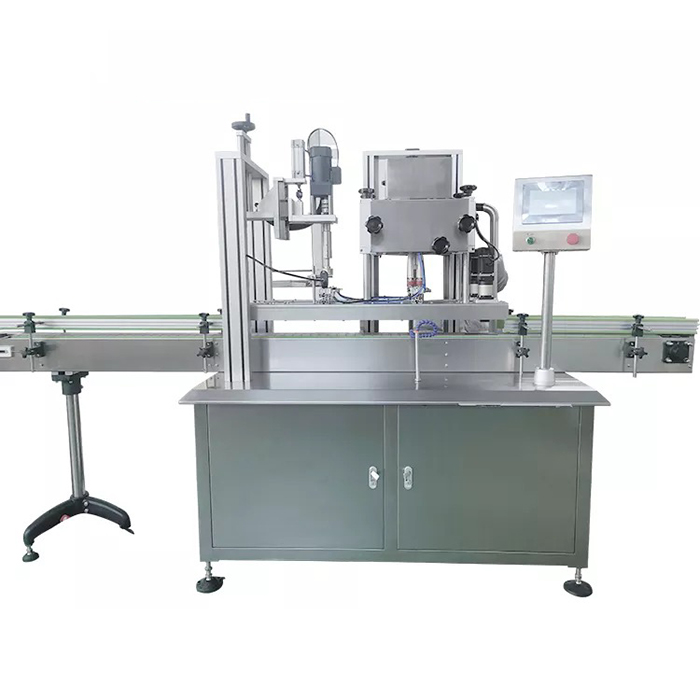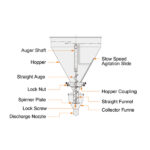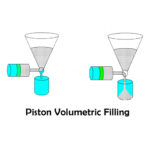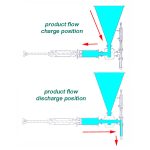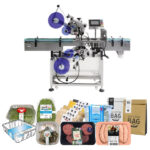While many different types of closures exist, there is one in particular that can be found on an extremely wide range of products. Screw-on type caps, or continuous thread caps, are used across many different industries and come in many different forms. Bottled water and soft drinks typically use simple, flat screw on caps. But products such as window cleaner or weed killer can use a screw-on cap with a sprayer. Hand soaps may use a screw-on closure with a pump. Other products may use sports caps, flip-top caps or a number of other varieties. However, each of these different types of screw-on caps are sealed by spinning and tightening the closure along the threads on the bottle.
What is a Screw Cap?
A screw cap or closure is a common type of closure for bottles, jars, and tubes. A screw closure is a mechanical device which is screwed on and off of a "finish" on a container. Either continuous threads or lugs are used. It must be engineered to be cost-effective, to provide an effective seal (and barrier), to be compatible with the contents, to be easily opened by the consumer, often to be reclosable, and to comply with product, package, and environmental laws and regulations. Some closures need to be tamper resistant and have child-resistant packaging features. A tamper-evident band is a common tamper warning for screw caps of bottles, for example.
Common Screw Caps
Non-dispensing screw caps seem like a little simple in structure compared to variant dispensing caps. But this cap is the most commonly used screw cap.


2. Flip top cap
The flip top cap is a member of our plastic dispensing caps family, they come in various sizes, colors, shapes, thickness and patterns so as to give wide options to choose.
3. Flip spout cap
The flip spout cap is one of the oldest design of dispensing caps, this type of closures could work well for several industrial applications, very easy to use
4. Twist Top Cap
Normally, every kind of dispensing cap has their certain application sector, it is important to select the appropriate orifice/opening for the product being dispensed.
5. Disc top caps
Disc top caps are very useful to our daily life, you can see commonly this dispensing cap for shampoo and personal care products, or other similar products, you press on one side.
6. Push/pull caps
Push/pull bottle caps are always used in sports bottles and dish detergent packaging. Each push/pull cap consists of a threaded base and a plastic spout, pull upward the spout to open and push down the spout to close as just like its name.
Triggers cap are both good for household use or professional use, you twist the nozzle to open before you use it, the length of trigger could be trimmed as you want.

The mist spray cap has a variety of solutions available, they feature an easy way to use similar to plastic pump, great for cleaning, travel, perfume, and many other liquid substances.

The plastic pumps are commonly seen in our daily life, many types of pump caps, including foamer pump, airless pump, lotion pump, treatment pump, etc.

Child-resistant screw caps (also referred as CR caps) are designed to prevent the children from potentially ingesting dangerous items, so child-resistant caps have been usually used in package drugs, cosmetics, and household chemicals or other hazardous products.

You can see tamper evident caps or tamper resistant caps are commonly used in beverage, food, and pharmaceutical market.

Metal screw caps are mostly suitable for food, medicine and other industries. The most common are olive oil and lug caps for sauces, For lug cap capping machine please see: Lug Capping Machine: The Ultimate Guide.

What is a Screw Capper?
A screw capper is used to securely apply plastic or metal threaded caps and other similar screw closures to bottles or containers at low and extremely high speeds. Not only can screw capper save a product line time and money, cappers also contribute to maintaining a sanitary work space.
Types of screw cappers based on the capping method
Each of different types of screw-on caps are sealed by spinning and tightening the closure along the threads on the bottle. Given this similarity, there are basically two ideal solutions for applying screw-on closures and for most projects, either machine will work.
1. Spindle Screw Cappers

2. Chuck Screw Cappers


Types of screw cappers based on degree of automation
In most cases, a packager moving from a hand-capping process to a capping machine will do so for speed. The key phrase in that sentence, however, is "in most cases". Hand capping can lead to inconsistent tightening, loose caps, cross-threaded caps and other issues due to human error or fatigue, among other things. Some manual and semi-automatic capping machines will be used to simply make the process more consistent and reliable, while automatic machinery will almost always speed up the sealing process.
Manual and Semi-Automatic Screw Cappers

Automatic Screw Capping Machines
Fully automatic screw capping machines are designed for the provision of continuous container capping in your packaging line. These types of machines come with conveyor and delivery systems for the lids. For instance, a cap elevator or a vibratory bowl. Automatic screw capping machines are controlled using a touch screen control panel and various levers and/or finger knobs that are necessary for the machine. While the operator of an automatic packaging line will still have to interact with the capping machine, the interaction is significantly reduced from that necessary with the manual and semi-automatic equipment. Consistency and reliability are still a big draw with the automatic cappers, but complete automation also means greater speed. Again, the type of closure used will go a long way toward determining which machine will be used, as well as secondary considerations such as bottle size, shape and desired speed.
Five Benefits Of Using Screw Capping Machines
As technology evolves, companies across industries are adopting new and innovative ways to enhance their competitive advantage. Screw capping machines, for instance, are increasingly becoming popular in the production sector. Industries, large and small, are tapping into the power of automation to boost production and meet their business goals.
1. Increased Speed And Efficiency
Semi-automatic and fully-automatic screw cappers are faster and more efficient. An automatic inline bottle screw capper, for instance, can handle up to 350 caps per minute. This helps boost the production rate, which translates to more products in the market, hence more revenue.
A streamlined production process also means there are fewer supply chain constraints. By balancing the supply and demand metrics, customers get their products in time. This helps boost customer satisfaction and repeat business.
The upfront cost of acquiring a fully-automatic screw capper may be high. However, it will save and even generate more money for your business in the long run.
2. Flexibility And Versatility
Thanks to their unique design, modern bottle capping machines allow for high-end flexibility. The majority of these machines are fully-automatic. They will handle different bottle designs, capsizes, and varying cap closures and fittings.
Regarding production requirements, screw capping machines are also quite versatile. Most automatic bottle cappers allow for easy adjustment of the operating speed.
3. Easy Operation
While capping machines require some set up post operation to ensure smooth production, once properly set (often done at the factory) the machines more or less run themselves! Conveyor railing, bottle stabilizing components or sealing components may all need to be adjusted when a new bottle is run, as well as the cap delivery system, but once up and running, operators need only ensure bulk caps and bottles are available! Again, rather than assisting with each bottle, automatic machines let the operator spend a few minutes setting up before freeing that person to do other packaging tasks!
4. Consistent And Reliable Operation
Besides being fast and efficient, capping machines ensure consistent operation. Unlike human labor, that’s susceptible to fatigue, errors, and bias, machines are generally more reliable.
If you have strict production requirements, you can always adjust your production to meet those needs. And due to their reliable operation, you can predict future production levels with high-end accuracy.
5. Product Integrity And Security
When closures are being tightened or sealed in a consistent and reliable manner, a packager can also rest easy knowing that product will be secure in the given container. No leaking or spilling should be expected, and in some cases, tamper evident closures will ensure end users receive secure product knowing no one has opened or otherwise interfered with in a negative manner. The ability to repeatedly and reliably seal containers leads to a secure product for both the packager and the purchaser.
Components of a Screw Capper Machine
Since VKPAK’s screw cappers have fully automatic designs, the components listed below are of a fully automatic screw capping equipment.
Chuck Head
In screw chuck capper machines, a specialized clamp called a chuck head is used to hold the container being capped. The chuck head applies torque on the lid to create a seal.
Spindle Disks
For screw spindle capper machines, they use sets of spindle disks (usually 3-4 sets) that spin the caps down onto the container as the container moves to the capping station.
Cap/Lid Sorter and Feeder
The lid sorter sorts the right caps to be fed into the machine and its design will depend on the cap geometry the machine handles. On the other hand, the lid feeder of the screw capper equipment can either be a cap elevator or a vibratory bowl.
Cap Chute
The screw capper equipment requires the cap chute to hold the lids in place. It is responsible for placing the lids on the top of each bottle that passes through the spindles or chuck.
Conveyor Belts
The screw capper’s conveyor belts are vital parts of an automatic screw capper equipment. The machine will depend on these for the transportation of the containers towards the capping zone and to other parts of the machine. They are continuously moving and can either be made from metal or rubber materials. Moreover, they are essential in firmly guarding the containers during the capping process to prevent them from going off the capping line.
Drives, Gear Boxes, and Motors
These parts are also called the driving engine of your screw capper equipment. By working together, they help drive the other components of the machine for a smooth capping operation. You can set the speed of their movement on your capper equipment’s control panel.
Pulleys
The pulleys also play a vital role in the transport process in an automatic screw capper machine. They are connected to the belts and gears and assist in moving different parts of the machine. Their sizes are varied depending on your screw capping equipment’s design.
Shafts and Sprockets
These two work together in assisting the machine during the transmission of a rotary force to the shafts. Just like pulleys, motors, gearboxes, and drives, the shafts and sprockets are important components of the machine that are used to drive the capping process.
How Does A Screw Capper Work?
Since screw capping machines usually have two capping methods: spindle capping and chuck capping, how the spindle capping works please see: What is a Spindle Capper, here we mainly introduce how the chuck capping machine works.
Chuck screw cappers offer an alternative to spindle capping for screw-on, or continuous thread, type closures. Whether a spindle capper or a chuck screw capper is the better solution for any packaging project using a threaded closure will depend on several factors unique to each project. Below we take a look at how the chuck cappers tighten screw-on type caps and how it differs from the spindle capper.
Chuck capping machines are so named because they use a chuck, with or without an insert, to apply torque to the continuous thread closures. Unlike the spindle cappers, where spinning disks contact the outside of the cap to tighten the closures, the chuck will descend and cover the cap, then spin the cap to apply torque to the desired level.
Linear Tracking Bottle Screw Capping Sealing Machine

Like the spindle screw capper, the chuck capper will employ several stability components to ensure consistent and reliable tightening. However, the range of different caps is slightly lower than the spindle capper due to the chuck descending over the cap. So while the chuck capper can tighten typical screw-on type lids like those seen on bottled water and other beverages, including sports caps, it becomes more difficult to tighten closures with a chuck capper when using a trigger sprayer or pump type closure, for example.
The automatic chuck screw capper will use a cap delivery system to provide the caps to the bottles as they enter the capping area. The delivery system will typically consist of a cap elevator or vibratory bowl, which will reject caps that are not properly oriented for the capping machine. The delivery system moves caps to a chute, which then holds properly oriented caps in place for presentation to the bottle.

Most automatic chuck screw capping machines will then use starwheel indexing to stabilize bottles during the capping process. A starwheel can be thought of as a wheel with a specific number of cuts in it to hold bottles, giving it the appearance of a star. As bottles move into the starwheel from the conveyor system, they will be moved around the wheel. The chute will normally sit at an early point on the starwheel, allowing the bottles to collect a cap as it moves under the chute. The starwheel will stop and go as bottles move around the indexing system. The stopping points along the wheel will be programmed to halt bottles under one or more chuck heads on the capping machine. When in place, and stabilized by the starwheel cut, the chuck heads will descend and apply torque to the desired level. Capped bottles then continue around the starwheel to be released back to the power conveyor, moving to labeling, coding or other packaging tasks.
Chuck cappers are also available as semi-automatic machines as well, and at the semi-automatic level arguably outperform the semi-automatic spindle capper. Semi-auto spindle cappers are usually used when a smaller packager has a unique cap, such as the trigger or pump sprayers mentioned above. Semi-automatic chuck cappers range from simple handheld machines to user assisted tabletop and portable machines. Depending on the process, the semi-automatic chuck cappers can add speed to the capping process. Like the semi-automatic spindle capper, operator assisted chuck capping machines will add to the consistency and reliability of the capping process while removing the danger of repetitive motion injuries to employees who spend an entire shift hand-capping and tightening closures.
Customizing Your Screw Capping Machine
A separate tab on each product is titled options, which are generally non-standard features that can be added to the machine to customize and personalize it for each packager's project.
While a capping machine can be completely custom manufactured, from concept to engineering to manufacturing and actually running production, customization of a machine most often comes from the addition of the options found on the standard equipments. The options included on any given machine will depend on the product used, the container used, types of closures used, simple packager desire and a host of other factors. In this way, and because each machine is manufactured for the individual packagers project, every machine built by VKPAK is a custom packaging machine!
Factors to Consider
Before we start with the production of your required screw capper equipment, we make sure that we fully understand your actual needs so that we can create a machine that perfectly suits your production line. For this, there are many factors and questions that we need to answer which will have a great impact on your resulting customized machine:
- What type of screw capping equipment do you need?
- What can will you cap including the material type?
- What types of caps will you be using?
- What products will you be packaging?
- What is your product yield requirement?
- What is your factory’s size and layout?
- What are your other special requests?
Again, completely custom machinery will always be available from VKPAK, but the most common type of customization is making changes or additions to standard machinery to provide the best solution for the particular bottle, product, cap, seal or other component of a packagers project.
We not only offer quality equipment, we listen, we adapt to your needs. We offer advice, we look for the best approach to your project. We recommend the most cost effective equipment without sacrificing quality. It is our responsibility to ensure that all our customers receive every attention to detail to make the installation successful, cost-efficient and profitable.
Summary
The screw capping machine is the most popular capping equipment on the market at present. From manual, semi-automatic to fully automatic, from linear to rotary, numerous capping equipment can meet a variety of packaging needs. If you are looking for a screw capping machine, please contact us and we will provide you with the most suitable capping equipment.
Finally, We not only offer quality equipment, we listen, we adapt to your needs. We offer advice, we look for the best approach to your project. We recommend the most cost effective equipment without sacrificing quality. It is our responsibility to ensure that all our customers receive every attention to detail to make the installation successful, cost-efficient and profitable.

